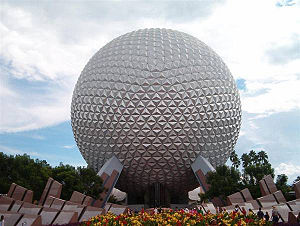Geodesic dome

A geodesic dome is a spherical or partial-spherical shell structure based on a network of great circles (geodesics) lying on the surface of a sphere. The geodesics intersect to form triangular elements that have local triangular rigidity and also distribute the stress across the entire structure. When completed to form a full sphere, it is known as a geodesic sphere.
A geodesic dome is not as symmetrical as it might appear, because the individual links (i.e., the "edges" of the triangular faces) must have slightly different lengths in order to give curvature to the overall surface. Typically the design of a geodesic dome begins by selecting one of the Platonic solids, such as an icosahedron inscribed in a sphere, tiling each triangular face with smaller triangles, and then projecting the vertices of each tile to the sphere. The endpoints of the links of the completed sphere would then be the projected endpoints on the sphere's surface. If this is done exactly, each of the edges of the sub-triangles is slightly different lengths, so it would require a very large number of links of different sizes. To minimize the number of different sizes of links, various simplifications are made. The result is a compromise consisting of a pattern of triangles with their vertices lying approximately on the surface of the sphere. The edges of the triangles form approximate geodesic paths over the surface of the dome that distribute its weight.
Geodesic designs can be used to form any curved, enclosed space. Oddly-shaped designs would require calculating each individual strut, vertex or panel -- resulting potentially expensive construction. Because of the expense and complexity of design and fabrication of any geodesic dome, builders have tended to standardize on a few basic designs.
Contents |
Related patterns
The principle of building strong stable structures out of patterns of reinforcing triangles is most commonly seen in tent design. It has been applied in the abstract in other industrial design, but even in management science and deliberative structures as a conceptual metaphor, especially in the work of Stafford Beer, whose syntegration method is based so specifically on dome design that only fixed numbers of persons can take part in the process at each deliberation stage.
History

The first dome that could be called "geodesic" in every respect was designed just after World War I by Walther Bauersfeld,[1] chief engineer of the Carl Zeiss optical company, for a planetarium to house his new planetarium projector. The dome was patented, constructed by the firm of Dykerhoff and Wydmann on the roof of the Zeiss plant in Jena, Germany, and opened to the public in 1922. Some thirty years later R. Buckminster Fuller further investigated this concept and named the dome "geodesic" from field experiments with Kenneth Snelson and others at Black Mountain College in the late 1940s. Although Fuller was not the original inventor, he developed and popularized the idea, and received a U.S. patent.
The geodesic dome appealed to Fuller because it was extremely strong for its weight, its "omnitriangulated" surface provided an inherently stable structure, and because a sphere encloses the greatest volume for the least surface area. Fuller had hopes that the geodesic dome would help address the postwar housing crisis. This was in line with his prior hopes for both versions of the Dymaxion House.

However, from a practical perspective, geodesic constructions do have some notable drawbacks. They have a very large number of edges in comparison with more conventional structures which have just a few large flat surfaces. Each of the edges must be prevented from leaking, which can be quite challenging for a geodesic structure. Also, spaces enclosed within curved boundaries tend to be less usable than spaces enclosed within flat boundaries. (Since it would be impractical to produce sofas with every possible curved shape, they are normally constructed along straight lines, and hence leave wasted space when placed in a curved space.)
The dome was successfully adopted for specialized industrial use, such as the 1958 Union Tank Car Company dome near Baton Rouge, Louisiana and specialty buildings like the Kaiser Aluminum domes (constructed in numerous locations across the US), auditoriums, weather observatories, and storage facilities. The dome was soon breaking records for covered surface, enclosed volume, and construction speed. According to a WAFB-TV of Baton Rouge news report on November 27, 2007, the Union Tank Car Company Dome has been demolished.
Leveraging the geodesic dome's stability, the US Air Force experimented with helicopter-deliverable units.
The dome was introduced to a wider audience as a pavilion at the 1964 World's Fair in New York City. This dome is now used as an aviary by the Queens Zoo in Flushing Meadows Corona Park.
Another dome from Expo 67 the Montreal, Canada World's Fair as part of the American Pavilion. The structure's covering later burned, but the structure itself still stands and, under the name Biosphère, currently houses an interpretive museum about the Saint Lawrence River.
In the 1970s the Cinesphere dome was built at the Ontario Place amusement park in Toronto, Canada. In 1975, a dome was constructed at the South Pole, where its resistance to snow and wind loads is important.
Residential geodesic domes have been less successful than those used for working and/or entertainment, largely because of their complexity and consequent higher construction costs. Fuller himself lived in a geodesic dome in Carbondale, Illinois, at the corner of Forest and Cherry. Unfortunately, residential domes have so far not caught on to the extent that Fuller hoped. He envisioned residential domes as air-deliverable products manufactured by an aerospace-like industry. Fuller's dome home still exists, and a group called RBF Dome NFP is attempting to restore the dome and have it registered as a National Historic Landmark.
Chord factors
|
|
A "chord" is a line segment lying on the surface of a circle or sphere. The chord factor of a dome indicates the number of times the "polyhedral face" is being subdivided when it is being projected onto the interior surface of the sphere. In this context, it is symbolized by the Greek letter "ν" (nu).
The chord in a dome is calculated as twice the sine of half the "central angle of the chord" (the central angle of the chord is the angle between the center point inside the sphere and the ends of the chord). Determining the central angle usually requires some non-trivial spherical geometry.
In Geodesic Math and How to Use It Hugh Kenner writes, "Tables of chord factors, containing as they do the essential design information for spherical systems, were for many years guarded like military secrets. As late as 1966, some 3v icosa figures from Popular Science Monthly were all anyone outside the circle of Fuller licensees had to go on." (page 57, 1976 edition)
Other tables became available with publication of Lloyd Kahn's Domebook 1 (1970) and Domebook 2 (1971). With advent of personal computers, the mathematics became more accessible. Rick Bono's Dome software, outputs a script that can be used with the POV-ray raytracer to produce 3D pictures of domes. Domes based on differing polyhedrals and differing chord factors produce differing results.
Advantages of domes
Of course, like all domes, geodesic domes provide an enclosed space free of structural supports. Domes are very strong, actually getting stronger as they get larger. The basic structure can be erected very quickly from lightweight pieces by a small crew. Domes as large as fifty meters have been constructed in the wilderness from rough materials without a crane. The dome is also aerodynamic, so it withstands considerable wind loads, such as those created by hurricanes. Solar heating is possible by placing an arc of windows across the dome: the more heating needed, the wider the arc should be, to encompass more of the year.
Today there are many companies that sell both dome plans and frame material with instructions designed simply enough for owners to build themselves, and many do to make the net cost lower than standard construction homes. Construction techniques have improved based on real world feedback over sixty years and many newer dome homes can resolve nearly all of the disadvantages below that were more true of the early dome homes.
Disadvantages of dome homes
As a housing system the dome can have numerous drawbacks and problems:
The shape of a dome house makes it difficult to conform to code requirements for placement of sewer vents and chimneys. Off-the-shelf building materials (e.g., plywood, strand board) normally come in rectangular shapes; there can be considerably more scrap, left from cutting rectangles down to triangles, than with a conventional building approach, thus driving costs up. Fire escapes are problematic; codes require them for larger structures, and they are expensive. Windows conforming to code can cost anywhere from five to fifteen times as much as windows in conventional houses. Professional electrical wiring costs more because of increased labor time. However, even owner-wired situations are costly, because more of certain materials are required for dome construction.
Air stratification and moisture distribution within a dome are unusual, and these conditions tend to quickly degrade wooden framing or interior paneling. Privacy is difficult to guarantee because a dome is difficult to partition satisfactorily. Sounds, smells, and even reflected light tend to be conveyed through the entire structure.
As with any sloping shape, the dome produces wall areas that can be difficult to use and leaves some peripheral floor area with restricted use due to lack of headroom. This can leave a volume that may require heating – representing a cost in energy – but that cannot be lived in. Circular plan shapes lack the simple modularity provided by rectangles. Furnishers and fitters usually design with flat surfaces in mind, and so placing a standard sofa (for example) results in a half-moon behind the sofa being wasted. This is best overcome by purpose-built fittings, though it adds to cost.
Dome builders using cut-board sheathing materials find it hard to seal domes against rain, because of their many seams; as well, these seams may be stressed because ordinary solar heat flexes the entire structure each day as the sun moves across the sky.
The most effective waterproofing method with a wooden dome is to shingle the dome, but even this can be a problem at the top of the dome where the slope is less than that required by most roofing materials (one solution is to add a peaked cap to the top of the dome or to modify the dome shape). One-piece reinforced concrete or plastic domes are also in use, and some domes have been constructed from plastic or waxed cardboard triangles that are overlapped in such a way as to shed water. Buckminster Fuller's former student J. Baldwin states that there is no reason for a properly designed, well-constructed dome to leak, and that some designs cannot leak (Bucky Works: Buckminster Fuller's Ideas for Today). However, Lloyd Kahn, after writing two books on the subject (Domebook 1 and Domebook 2), became disillusioned with domes. He calls domes "smart but not wise",[2] and has collected many of the criticisms given above.
Methods of construction

Wooden domes have a hole drilled in the width of a strut. A stainless steel band locks the strut's hole to a steel pipe. With this method, the struts may be cut to the exact length needed. Triangles of exterior plywood are then nailed to the struts. The dome is wrapped from the bottom to the top with several stapled layers of tar paper, in order to shed water, and finished with shingles. This type of dome is often called a hub-and-strut dome because of the use of steel hubs to tie the struts together.
Panelized domes are constructed of separately-framed timbers covered in plywood. The three members comprising the triangular frame are often cut at compound angles in order to provide for a flat fitting of the various triangles. Holes are drilled through the members at precise locations and steel bolts then connect the triangles to form the dome. These members are often 2x4's or 2x6's, which allow for more insulation to fit within the triangle. The panelized technique allows the builder to attach the plywood skin to the triangles while safely working on the ground or in a comfortable shop out of the weather. This method does not require expensive steel hubs.
Temporary greenhouse domes have been constructed by stapling plastic sheeting onto a dome constructed from one-inch square beams. The result is warm, movable by hand in sizes less than 20 feet, and cheap. It should be staked to the ground to prevent it being moved by wind.
Steel-framework domes can be easily constructed of electrical conduit. One flattens the end of a strut and drills bolt holes at the needed length. A single bolt secures a vertex of struts. The nuts are usually set with removable locking compound, or if the dome is portable, have a castle nut with a cotter pin. This is the standard way to construct domes for jungle-gyms.
Concrete and foam plastic domes generally start with a steel framework dome, wrapped with chicken wire and wire screen for reinforcement. The chicken wire and screen is tied to the framework with wire ties. A coat of material is then sprayed or molded onto the frame. Tests should be performed with small squares to achieve the correct consistency of concrete or plastic. Generally, several coats are necessary on the inside and outside. The last step is to saturate concrete or polyester domes with a thin layer of epoxy compound to shed water.
Some concrete domes have been constructed from prefabricated, prestressed, steel-reinforced concrete panels that can be bolted into place. The bolts are within raised receptacles covered with little concrete caps to shed water. The triangles overlap to shed water. The triangles in this method can be molded in forms patterned in sand with wooden patterns, but the concrete triangles are usually so heavy that they must be placed with a crane. This construction is well-suited to domes because there is no place for water to pool on the concrete and leak through. The metal fasteners, joints and internal steel frames remain dry, preventing frost and corrosion damage. The concrete resists sun and weathering. Some form of internal flashing or caulking must be placed over the joints to prevent drafts. The 1963 Cinerama Dome was built from precast concrete hexagons and pentagons.
Largest geodesic dome structures
Many geodesic domes built are still in use. According to the Buckminster Fuller Institute,[3] the world's ten largest geodesic domes are:
- Fantasy Entertainment Complex: Kyosho Isle, Japan, 710 ft (216 m) [1]
- Multi-Purpose Arena: Nagoya, Japan, 614 ft (187 m) [2]
- Tacoma Dome: Tacoma, Washington, USA, 530 ft (161.5 m)
- Superior Dome: Northern Michigan University. Marquette, Michigan, USA, 525 ft (160 m)[3]
- Walkup Skydome: Northern Arizona University. Flagstaff, Arizona, USA, 502 ft (153 m) [4]
- Round Valley High School Stadium: Springerville-Eagar, AZ, USA, 440 ft (134 m)
- Former Spruce Goose Hangar: Long Beach, California, USA, 415 ft (126 m)
- Formosa Plastics Storage Facility: Mai Liao, Taiwan, 402 ft (122 m)
- Union Tank Car Maintenance Facility: Baton Rouge, Louisiana, USA, 384 ft (117) m (Demolished in November 2007.) [5]
- Union Lehigh Portland Cement Storage Facility: Union Bridge, Maryland, USA, 374 ft (114 m)
See also
- Dome
- Concrete dome
- Cloud nine (Tensegrity sphere)
- Domed city
- Fullerenes, molecules which resemble the geodesic dome structure
- Hoberman sphere
- Monolithic dome
- Radome
- Silent Running 1972 science fiction film prominently featuring geodesic domes.
- Space frames
- Stepan Center
- Shell structure
- Gridshell
- Truss
- Geodesic tents
References
- ↑ First Geodesic Dome: Planetarium in Jena 1922 incl. patent information
- ↑ "Refried Domes" by Lloyd Kahn
- ↑ "World's 10 Largest Domes". Buckminster Fuller Institute.
External links
- The R. Buckminster Fuller FAQ: Geodesic Domes
- Build Your Own Geodesic Dome
- The Mathematics behind Geodesic Domes and Spaceframes
- Geodesic Dome Notes: 57 dome variants featured (1V to 10V) of various solids (icosa, cube, octa, etc)
- Article about the Eden Domes (PDF file 5.1 MB)
- Construction of the Eden Project Biomes
- Geodaetische Kuppeln (Geodesic Dome) by T.E. Dorozinski
- Geometry Dome: geodesic dome design without corner connectors, featured in the Guggenheim Museum and at BurningMan
- Shape optimization of Shell and Spatial structure
- Creating Paper and Plastic Domes shows two original dome model designs

